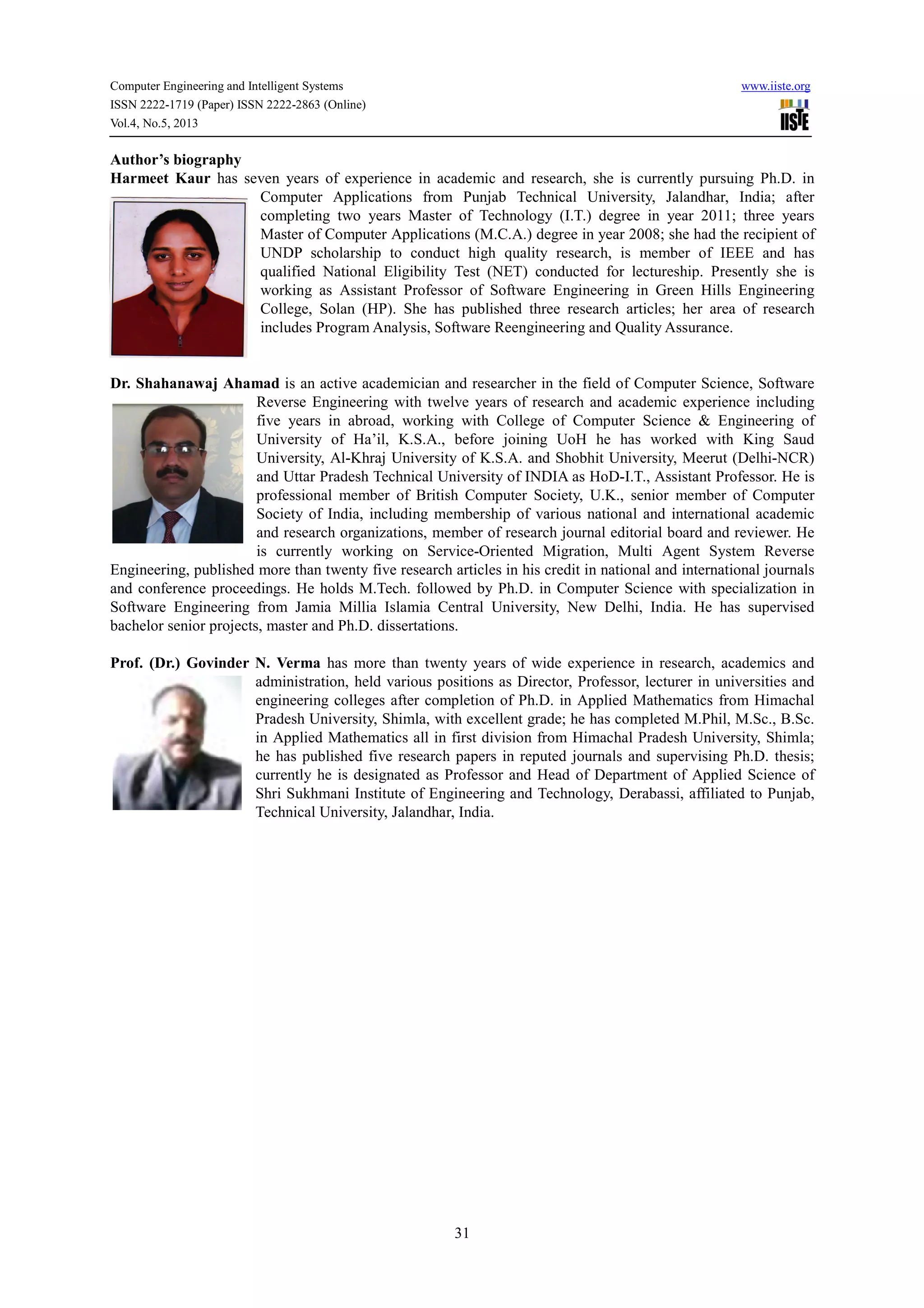This document discusses parameters for improving program quality from a reengineering perspective. It begins with an introduction stating that software development is complex and dynamic, so programs must be flexible, reusable and scalable. It then reviews literature on various software quality models proposed over decades to identify quality parameters. These parameters affect program design, functionality, performance and other attributes. The document emphasizes that considering quality parameters at each development stage can help produce programs that meet requirements and are suitable for reengineering.

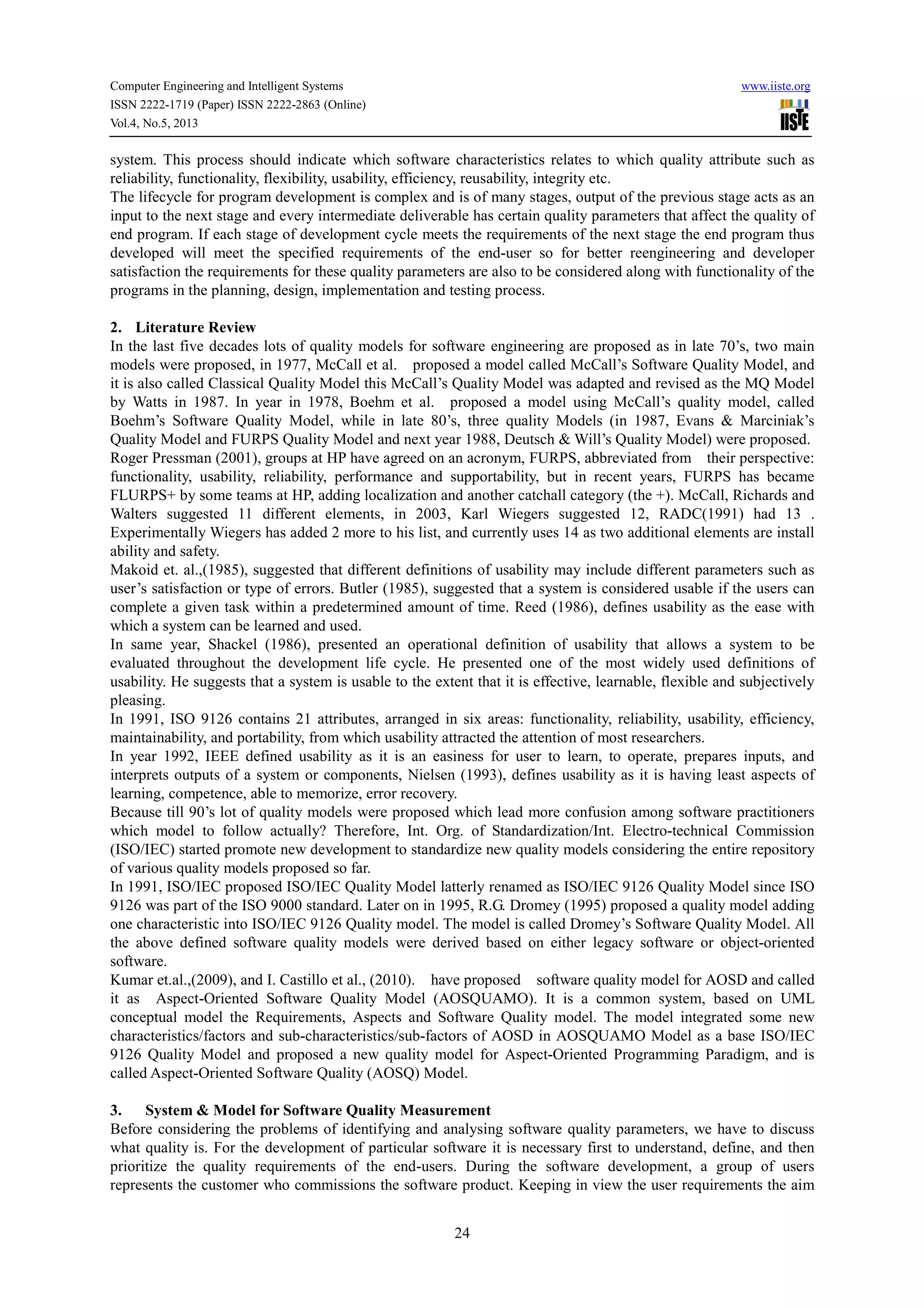
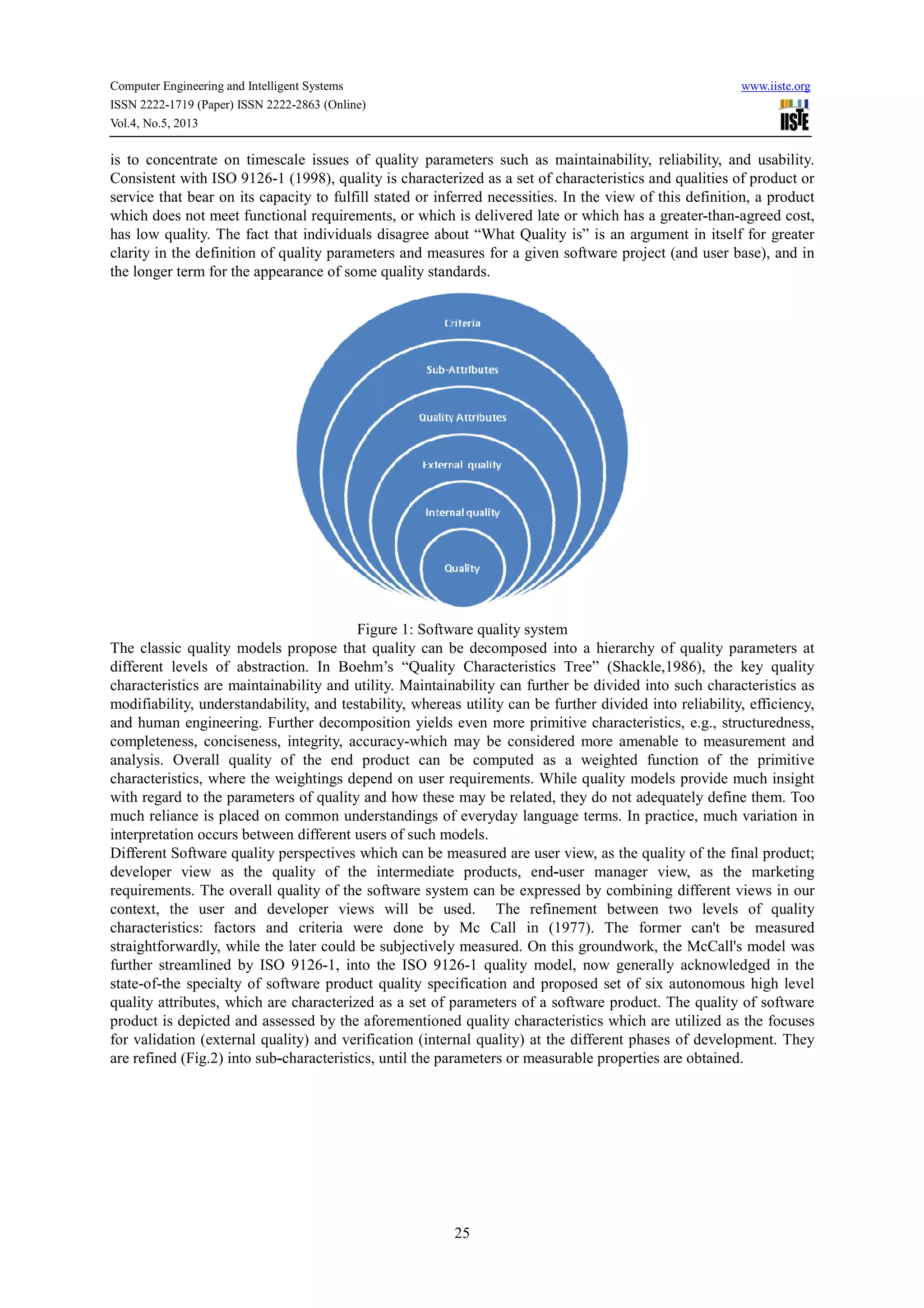
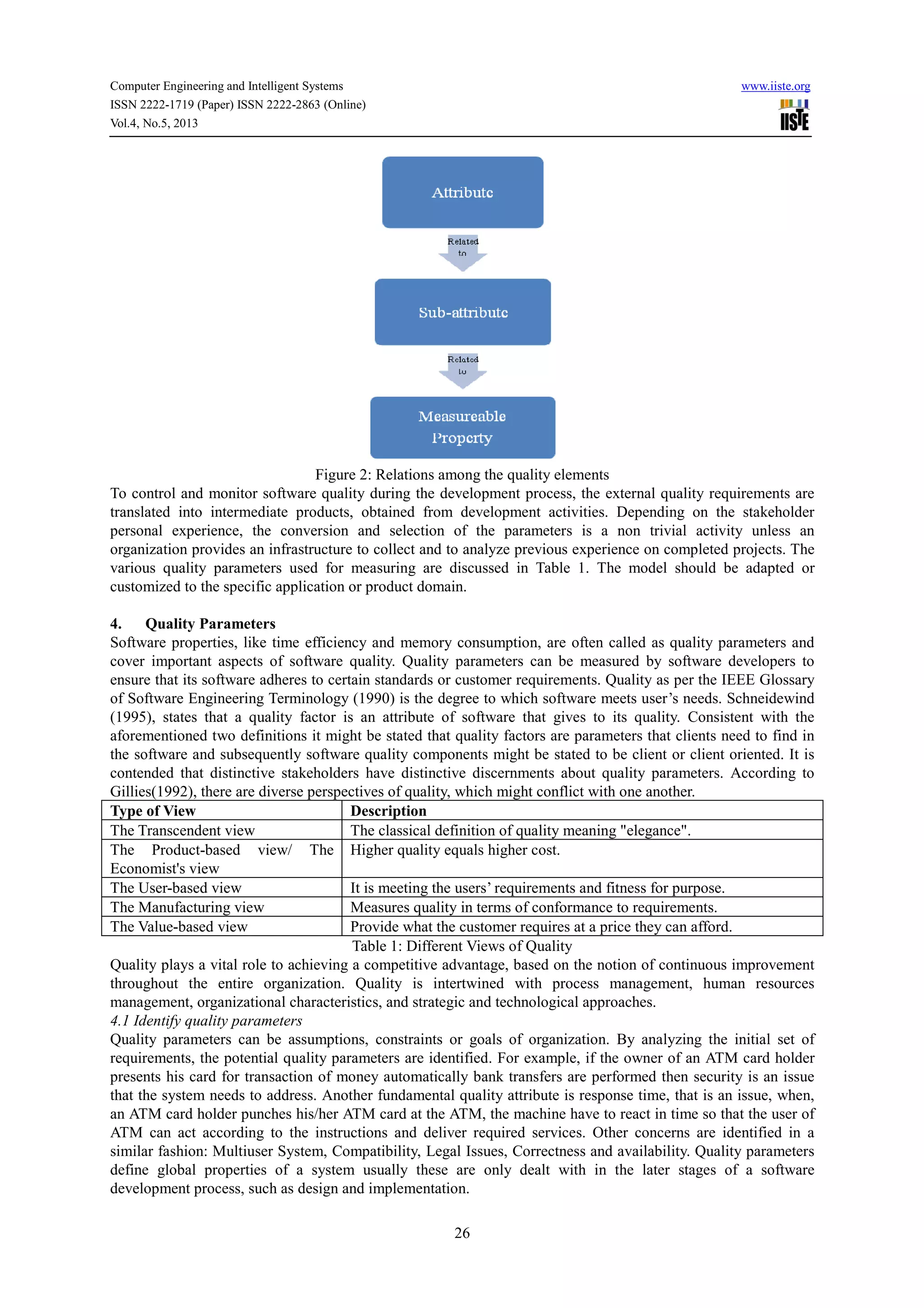
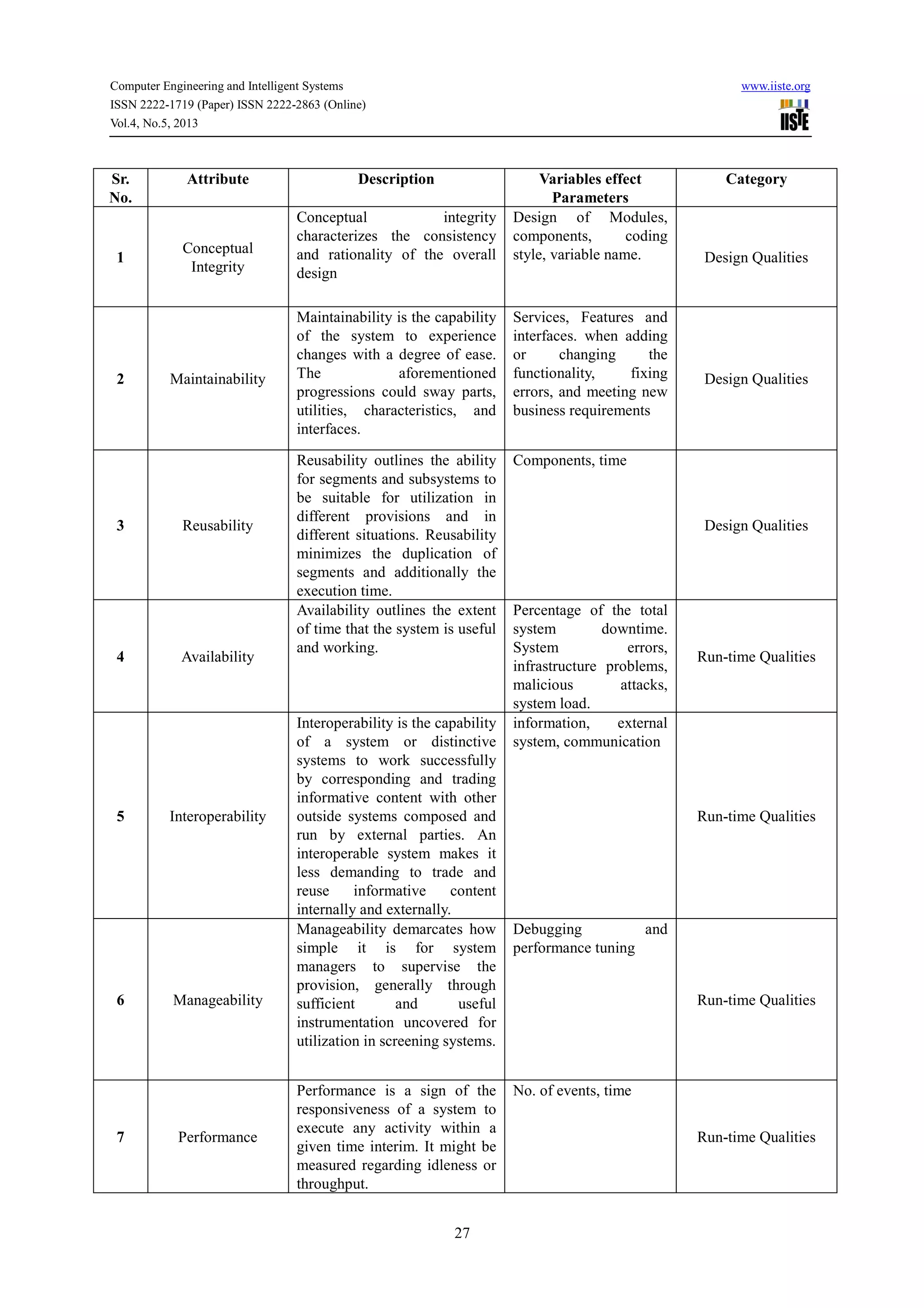
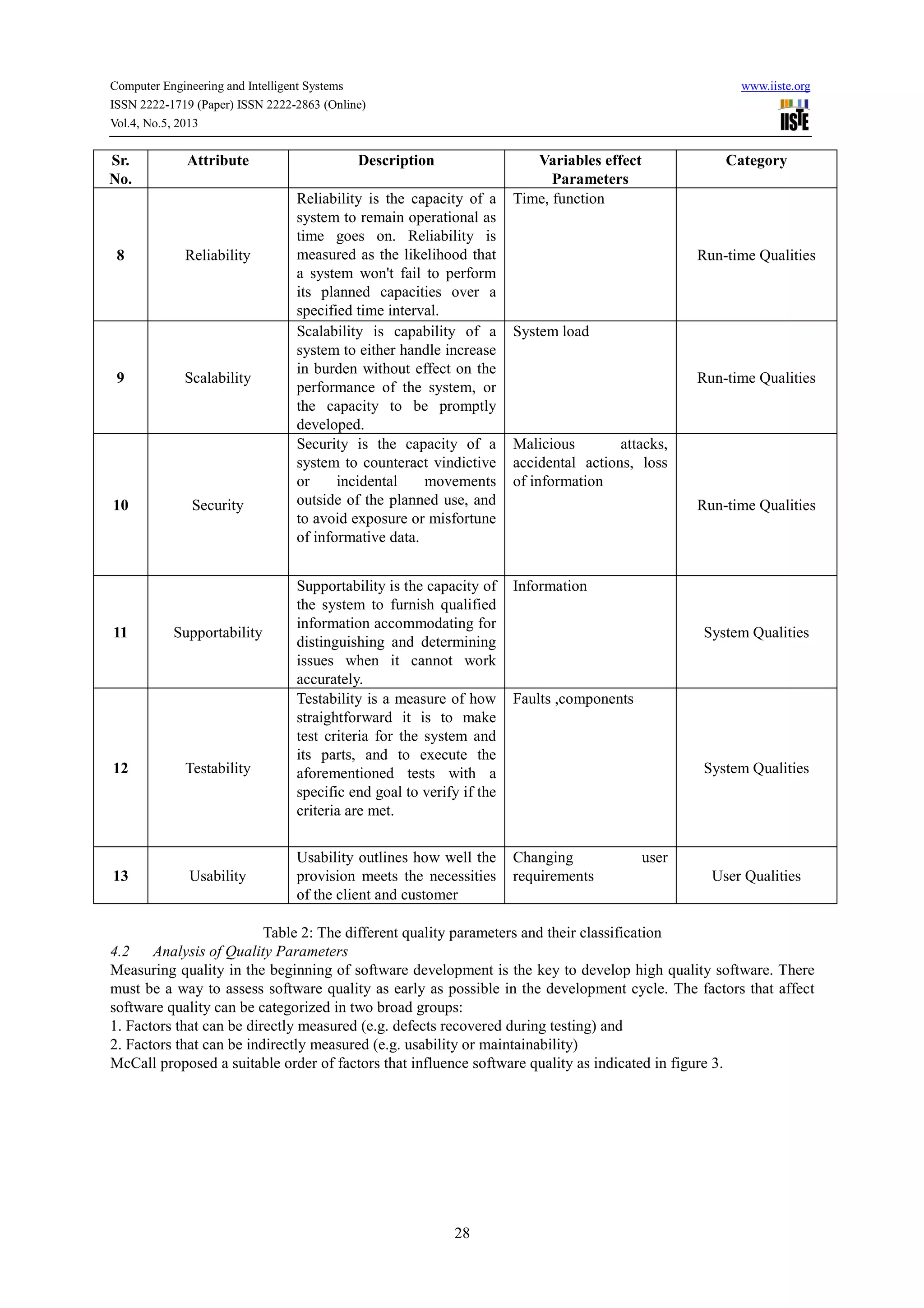
![Computer Engineering and Intelligent Systems www.iiste.org
ISSN 2222-1719 (Paper) ISSN 2222-2863 (Online)
Vol.4, No.5, 2013
29
Figure 3: McCall's Quality factors
It is evident from the figure that during various phases of software development various quality parameters and
sub parameters affect the quality of the software. During the product operation phase correctness, reliability,
usability, integrity and efficiency play important role in the quality of the software product where as in product
transition phase quality is affected by interoperability, portability and usability. In product revision phase
maintainability, flexibility and testability are important factors of the software product. In this phase the product
is tested for errors and it is closely observed whether it is maintainable and flexible. As far as the quality of the
software is concerned it is affected by its parameters and sub-parameters such as functionality, usability,
reliability, portability, supportability. Usability of the software is related to number of error messages and the
length of the user manual that is lesser the numbers of errors greater will be its usability whereas portability is
size of the program measured in LOC (Line of code) and number of parameters. Reliability is affected by LOC,
cyclomatic complexity and number of error messages portability, and usability are interrelated more is the
portability more will be its usability which will enhance the reliability and increases the functionality of the
software system and leads to the development of the quality software.
For any software system correctness is one of the most important attribute which is required for proper working
of the software. Another factor of concern is maintainability; which can be corrective and adaptive. Corrective
maintainability deals with fixation of errors whereas, adaptive maintainability deals with changes in the
requirement of the user and perfective changes deals with requirement of the software. Maintainability is directly
proportional to the amount of re-work.
5. Conclusion
During the study it is observed that quality parameters and sub- parameters play a very important role in the
development of the quality software system. Quality of software is affected by number of parameters for
example conceptual integrity is influenced by variable name, coding style whereas availability is affected by
malicious attacks, system load etc. The various existing quality parameters are identified, discussed and analyzed
and it is seen that reliability, portability and usability are closely related to each other. As far as the
maintainability of the software system is concerned it is directly proportional to the amount of rework.
References
[1] B. W. Boehm, et.al.,(1978), “Quantitative Evaluation of Software Quality,” IEEE Computer Society Press,
Page No.: 592 – 605.
[2] Butler, K. (1985): Connecting Theory and Practice: A Case Study of Achieving Usability Goals, In
Proceedings of CHI 85, ACM, New York, pp. 85-88.
[3] Castillo,et.al.,(2010), “REquirements, Aspects and Software Quality: the REASQ model,” Journal of Object
Technology, Volume 9, Number 4, Page No.: 69 – 91.
[4] Fenton, et.al.,(1995),1995,” Software Quality Assurance and Measurement, A Worldwide Perspective”
International Thomson Computer press, London.
[5] Francisca Losavio et.al., 2003,“Quality Characteristics for Software Architecture” Online at www.jot.fm.
Published by ETH Zurich, Chair of Software Engineering Vol. 2, No. 2.](https://image.slidesharecdn.com/identificationanalysisofparametersforprogramqualityimprovementareengineeringperspective-130619021327-phpapp02/75/Identification-analysis-of-parameters-for-program-quality-improvement-a-reengineering-perspective-7-2048.jpg)
![Computer Engineering and Intelligent Systems www.iiste.org
ISSN 2222-1719 (Paper) ISSN 2222-2863 (Online)
Vol.4, No.5, 2013
30
[6] Gillies Alan C.,(1992), “Software Quality, Theory and management” London, Chapman & Hall.
[7] IEEE, (1990) “IEEE Glossary of Software Engineering Terminology”, 610.12.
[8] ISO/IEC 9126-1, (2001), “Software Engineering - Product Quality- Part 1: Quality Model”, International
Organization for Standardization, Switzerland.
[9] ISO/IEC 9126-2, (2002), “Software Engineering - Product Quality- Part 2: External Metrics”,
[10] International Organization for Standardization, Switzerland.
[11] ISO/IEC 9126-3, (2003), “Software Engineering - Product Quality- Part 3: Internal Metrics”,
[12] International Organization for Standardization, Switzerland.
[13] J. A. McCall, et.al.,(1977), “Factors In Software Quality - Concept and Definitions of Software Quality,”
Rome Air Development Center, Air Force Systems Command, Griffiss Air Force Base, New York, Vol. 1, No. 3.
[14] J. Tian,(2005), “Software Quality Engineering-Testing, Quality Assurance and Quantifiable.
[15] Improvement,” IEEE Computer Society, 2005.
[16] Karl Wiegers,(2003), Software Requirements (2nd Edition), Microsoft Press,ISBN 0735618798.
[17] Makoid, L., Forte, C., and Perry, J., (1985), “ An Empirical Model for Usability Evaluation Based on the
Dynamics of the Human-Computer Interface”, Technical Report TR-85-15, North Carolina State University.
[18] Msdn library http://msdn.microsoft.com/en-us/library/ee658094.aspx
[19] Nielsen, J., (1993), Usability Engineering, Academic Press.
[20] R. G. Dromey,(1995), “A Model for Software Product Quality,” IEEE Transactions on Software
[21] Engineering, Volume 21 Number 2, Page No.: 146 - 162.
[22] Roger Pressman,(2001), Software Engineering: A Practitioner’s Approach (5th Edition), McGraw Hill,ISBN
0073655783
[24] The Rome Air Development Center is now the Rome Laboratory, as of 1991.
[25] Reed, P., (1986),” Usability Testing in the Real World”, In Proceedings of CHI 86, ACM, Boston, 212.
[26] Shackel, B. (1986), “Ergonomics in design for usability”, In Harrison, M. D. and Monk, A. F., editors,
People and computers, Proc. Second conf. of the BCS HCI specialist group, pp. 45–64, Cambridge, Cambridge
University Press.
[27] Schneidewind Norman. F.,(1995), “ Controlling predicting the quality of space shuttle software using
metrics”, Software Quality Journal 4, 49-68.](https://image.slidesharecdn.com/identificationanalysisofparametersforprogramqualityimprovementareengineeringperspective-130619021327-phpapp02/75/Identification-analysis-of-parameters-for-program-quality-improvement-a-reengineering-perspective-8-2048.jpg)
